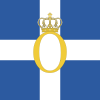

Carl Wilhelm von Heideck (Greek: Κάρολος φον Χέυδεκ, born in Sarralbe, Moselle, on 6 December 1788 – died in Munich on 21 February 1861) was a Bavarian military officer, a philhellene and painter.
Biography
Von Heideck studied art in Zürich. In 1801, he entered the military academy in Munich. Since 1805 he was in the Bavarian army, taking part in campaigns in Austria, Prussia and Tyrol, and then in Spain after 1810.
In 1814, with the rank of major, he accompanied the crown prince and future Ludwig I of Bavaria to the Congress of Vienna.
In 1826, he went to help the Greeks fight for their independence against the Ottoman Empire, during the Greek War of Independence.
In 1827, he took part under the orders of Thomas Gordon to the attempt to help the Acropolis of Athens. In June of the same year he bought three ancient Greek statues, including the Nike of Megara, just a month after the Provision of the Third National Assembly at Troezen that explicitly banned the sale and export of antiquities; thus he was not able to get the three statues out of the country.
In 1828, Ioannis Kapodistrias named him commander of Nafplion and a few months later military governor of Argos.
In 1830, he went back to Munich and got back his rank of colonel of the Bavarian army. He started again to paint.
In 1832, when Otto the second son of Ludwig I of Bavaria was designated to become king of Greece, Heideck was nominated to the regency council. It is traced, that he lived at Kasern Straße 12 (today Leonrodstraße) in Munich around 1850. The Heideckstraße in the quarter Neuhausen of Munich is named after him.
Notes and references
- In German personal names, von is a preposition which approximately means 'of' or 'from' and usually denotes some sort of nobility. While von (always lower case) is part of the family name or territorial designation, not a first or middle name, if the noble is referred to by their last name, use Schiller, Clausewitz or Goethe, not von Schiller, etc.
- Tsouli, Chrysanthi (2021). "Chronicle of a journey. The Nike of Megara at the National Archaeological Museum". In Maria Lagogianni-Georgakarakos (ed.). Known and Unknown Nikai. Athens, Greece: Greek Ministry of Culture and Sports. p. 305. ISBN 978-960-386-512-4.
- Leonrodstraße, City of Munich.
- Paul Maucher: Alphabetic register of house owners 1849–1851 Archived 2009-03-06 at the Wayback Machine, p. 21.
- Die Königlich-Bayerische Armee im westlichen Straßenbild Archived 2017-06-16 at the Wayback Machine (German), Taxi-Kurier, April 2007, p. 37
| Greece during the reign of Otto (1832–1862) | ||
|---|---|---|
| Capital |  | |
| Monarchs | ||
| Regency Council | ||
| Prime Ministers |
| |
| Architects | ||
| Notable People | ||
| Early Greek Parties | ||
| Events | ||
| Influence |
| |
| Structures | ||
| Institutions |
| |
| Other | ||
- History of Greece (1832–1862)
- 1788 births
- 1861 deaths
- 19th-century regents of Greece
- People from Moselle (department)
- Military personnel of Bavaria
- Bavarian generals
- 19th-century German painters
- 19th-century German male artists
- German male painters
- German philhellenes in the Greek War of Independence
- Naturalized citizens of Greece
- Hellenic Army officers
- German military personnel of the Napoleonic Wars